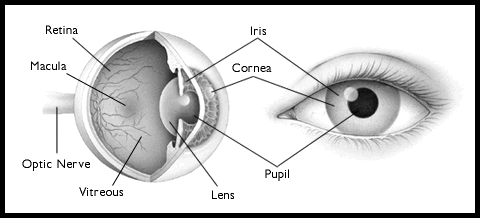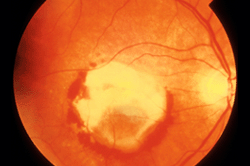|
|
|
What is AMD?
Age-related macular degeneration (AMD) is a degenerative condition
affecting the central area of the retina called the macula. The macula
is a small area at the back of the eye which is responsible for fine and
reading vision. Conditions affecting the macula reduce the central vision,
leaving the peripheral vision intact - for example, you could see the outline
of a clock but not be able to tell what time it is. It affects both distance
and close vision and can make some activities, like reading, difficult
or impossible.

How Common is AMD?
In people aged in their 50s, end stage AMD is found in 1-2% of people.
This number increases to 28% in people in their 80s. It is the 2nd commonest
cause of vision loss in India
What are the symptoms of AMD?
Macular degeneration can cause different symptoms in different people.
The condition can be hardly noticeable in its early stages. Initially patients
notice difficulties with near tasks such as sewing. Reading may become
more difficult, with the print "fading" or "running together" and brighter
illumination required. Straight lines may look distorted.
Later, central vision may become very poor with dark or empty areas
appearing in the centre of vision. Patients may be unable to read.


vision with AMD eye
vision with normal eye
What are the causes and risk
factors?
Many older people develop AMD as part of the body's natural ageing
process. AMD may run in families but also many cases do not seem to have
a family history.
Research have been attempted to find a gene or genes responsible for
AMD. Finding the genes involved would help us to detect people at risk
at an early age and help us to find more effective treatments.
It is now know that smoking is a risk factor for AMD. Smoking makes
you six times more likely to have severe visual loss.
Types of AMD
Two two most common forms of AMD are "dry" (atrophic) and "wet" (exudative).
Most people have "dry" macular degeneration. It is caused by the thinning
of the tissues of the macula. Vision loss is usually gradual.
The "wet" form is characterized by the development of abnormal blood
vessel mambranes beneath the retina which may leak fluid or bleed, eventually
resulting in a scar in the macula. Ophthalmologists screen for the early
detection of this complication by using an Amsler
Chart as prompt action is required for best results.

Treatment for AMD
Unfortunately, the cause of macular degeneration is unknown. Although
your ophthalmologist will be able to readily detect the disease during
an eye exam, he or she won't be able to cure it. The goal is to help the
patient see better and stabilize the condition.
The "dry" form has no effective treatment at present, although a healthy
diet with fresh fruit and green vegetables to add anti-oxidants and other
nutrients needed for a healthy retina is recommended.
The abnormal blood vessel membranes that develop in the "wet" form
may sometimes be treated with laser to the retina - this is a brief and
usually painless outpatient procedure. The treatment is more likely to
be able to be used the earlier the patient is seen. The laser seals the
leaking blood vessels that damage the macula. Although a small "blind spot"
is left at the point of laser contact, the procedure can preserve more
sight overall.
Recently a new form of laser treatment known as "Photodynamic Therapy"
has been found to be effective for some cases. Experimental treatments
include radiotherapy, anti-inflammatory medication for the eye and retinal
surgery.
Despite advanced medical treatment, people with macular degeneration
still experience some vision loss. The "good" news about macular degeneration
is that even though people who have it experience mild to severe vision
loss, macular degeneration does not side vision. One does not go blind.
With the help of low vision aids, people can continue with many of their
favourite activities and can still lead normal, independent lives.